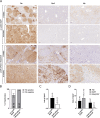A versatile transposon-based technology to generate loss- and gain-of-function phenotypes in the mouse liver
- PMID: 35361222
- PMCID: PMC8974095
- DOI: 10.1186/s12915-022-01262-x
A versatile transposon-based technology to generate loss- and gain-of-function phenotypes in the mouse liver
Abstract
Background: Understanding the contribution of gene function in distinct organ systems to the pathogenesis of human diseases in biomedical research requires modifying gene expression through the generation of gain- and loss-of-function phenotypes in model organisms, for instance, the mouse. However, methods to modify both germline and somatic genomes have important limitations that prevent easy, strong, and stable expression of transgenes. For instance, while the liver is remarkably easy to target, nucleic acids introduced to modify the genome of hepatocytes are rapidly lost, or the transgene expression they mediate becomes inhibited due to the action of effector pathways for the elimination of exogenous DNA. Novel methods are required to overcome these challenges, and here we develop a somatic gene delivery technology enabling long-lasting high-level transgene expression in the entire hepatocyte population of mice.
Results: We exploit the fumarylacetoacetate hydrolase (Fah) gene correction-induced regeneration in Fah-deficient livers, to demonstrate that such approach stabilizes luciferase expression more than 5000-fold above the level detected in WT animals, following plasmid DNA introduction complemented by transposon-mediated chromosomal gene transfer. Building on this advancement, we created a versatile technology platform for performing gene function analysis in vivo in the mouse liver. Our technology allows the tag-free expression of proteins of interest and silencing of any arbitrary gene in the mouse genome. This was achieved by applying the HADHA/B endogenous bidirectional promoter capable of driving well-balanced bidirectional expression and by optimizing in vivo intronic artificial microRNA-based gene silencing. We demonstrated the particular usefulness of the technology in cancer research by creating a p53-silenced and hRas G12V-overexpressing tumor model.
Conclusions: We developed a versatile technology platform for in vivo somatic genome editing in the mouse liver, which meets multiple requirements for long-lasting high-level transgene expression. We believe that this technology will contribute to the development of a more accurate new generation of tools for gene function analysis in mice.
Keywords: Fah KO mouse; In vivo gene silencing; Sleeping Beauty; Somatic transgenesis; Tumor model.
© 2022. The Author(s).
Conflict of interest statement
The authors declare that they have no competing interests.
Figures



References
Publication types
MeSH terms
LinkOut - more resources
Full Text Sources
Other Literature Sources
Molecular Biology Databases
Research Materials
Miscellaneous

